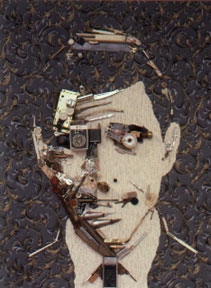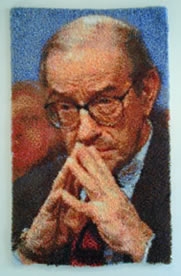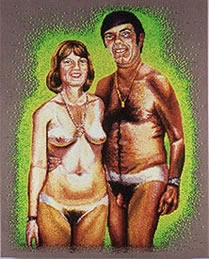Feature: Reviews
You Oughta Be in Pictures
- Lizabeth Oliveria Gallery
- San Francisco, CA
- January 5 - February 2, 2002
Forget sex, toys sell. New York galleries in particular have been fervently mounting show after show of art made with all manner of playthings. A recent sequel-show at Kagan Martos Gallery, Toys II (where the II could stand for II years of nonstop amusement!), even roused Andy Warhol from the dead and propped his work up next to Jeff Koons’s, Haim Steinbach’s, and a slew of emerging artists in a cornucopia of play.
The demand for work made with toys seems understandable, to a degree. Action figures and Barbie dolls were the protagonists in many a child’s first constructed narratives. Looking back on these objects allows us at once to remember a time when we had fewer responsibilities and to laugh at either our naiveté or the extent to which we based our self-worth on the size of our Star Wars collection. Now that other variables have replaced storm troopers and ewoks in the equation that is “self-identity,” the contents of the toy box have taken on an entirely new meaning.
But does there come a point at which the medium becomes less important? Can a work of art signify on its own? At present it seems impossible to divorce message from medium in a world where there is no degree zero of representation and every delicate pixel is part and parcel of an utterance. Nevertheless, critics learned how to separate the content of a Vermeer from the technology of his paints, or the subjects of Sander from the gelatin silver print. Granted, we’re moving a bit slower in new media and the genre of sculpture or painting we call “mixed media,” but one must wonder: What difference does it make that toy-based work is toy-based, and what would that work say in other media?
Although the recent group show at Oakland’s Lizabeth Oliveria Gallery was only 66.66 percent toys (the third artist worked in hooked rugs), it had a nostalgic audience crying “que Seurat” over the fun if cynical work. You Oughta Be in Pictures was a three-person show comprised of mixed-media portraits. Jason Mecier presented images of the Twilight Zone’s Rod Serling, Linda Blair, and the Rock. Each assemblage was constructed of materials that seemed only loosely correlative to the subject of the portrait. For instance, the Rock was rendered in WWF ephemera. Each image was unique in its lack of grounding in any object more permanent than the gallery wall. Still, there was a distracting ambiguity in the relationship between the materials used and the persona presented. Great care was obviously taken in selecting the materials, yet there was no coherent system of signification. While WWF translates to the Rock, keys and office supplies do not a Rod Serling make. Without a decoder ring, the clearest interpretation was that the artist was representing pop icons in popular materials. Certainly there were intimations of the corporatization of a person’s image and even the object choices of the toy consumer. Nevertheless, the slippage between the presumed intentionality of the media and the subject may have corrupted the proposed photo-reality of the portrait.
Not that mimesis is important anymore, but Rob Conger was far more successful in proving the curatorial thesis that everyday objects can create “realistic” images in less everyday ways. Conger showed three hooked-rug portraits of the not-so-photogenic Alan Greenspan. Accurately capturing Greenspan — complete with chicken-skin folds and camera-light glare atop the Fed chairman’s balding head — these tapestries of bygone childhoods contemplated more poignantly the themes of commerce, material culture, and identity.
By far, it was Steve DeFrank who stole the show, not because he was given the most wall space but because of the depth of content in his work. DeFrank contributed three Lite-Brite portraits and a large self-portrait made of hundreds of Fisher Price characters, each uniquely painted and cast to be anatomically correct. A splashy, bubble-gum-sweet portrait of childhood love object Mark Spitz contrasted nicely with a portrait of the artist’s parents, naked save for their blinding white tan lines, 1970s coiffures, and smiling, leathery faces. The artist has created thousands of unique colors for the Hasbro-made pegs, and in a true mark of pointillist success, when photographed or seen from a distance, the images look fluid. Rendering the images in toy box relics should not brand DeFrank a crowd-following gimmick man. The work is exceptionally detailed and comes second, if only in process, to DeFrank’s brilliant — and, unfortunately, rarely exhibited — paintings.
Just one in a string of curatorially successful shows, You Oughta Be in Pictures confirmed Oliveria’s new foothold in the bay area art community, on the eve of her move to San Francisco.



